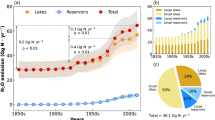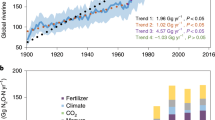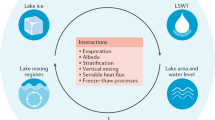Abstract
Nitrogen oxides affect health and climate. Their emissions, in the form of nitric oxide, from inland waters such as lakes are generally considered negligible and are absent in air quality and climate models. Here we find unexpected high emissions of nitric oxide from remote lakes on the Tibetan Plateau, based on satellite observations of tropospheric nitrogen dioxide vertical column densities and subsequent emission inversion at a fine resolution of 5 km. The total emissions from 135 lakes larger than 50 km2 reach 1.9 metric tons N h−1, comparable to anthropogenic emissions in individual megacities worldwide or the Tibet Autonomous Region. On average, the emissions per unit area reach 63.4 μg N m−2 h−1, exceeding those from crop fields. Such strong natural emissions from inland waters have not been reported, to the best of our knowledge. The emissions are derived from microbial processes in association with substantial warming and melting of glacier and permafrost on the plateau, constituting a previously unknown feedback between climate, lake ecology and nitrogen emissions.
This is a preview of subscription content, access via your institution
Access options
Access Nature and 54 other Nature Portfolio journals
Get Nature+, our best-value online-access subscription
$29.99 / 30 days
cancel any time
Subscribe to this journal
Receive 12 print issues and online access
$259.00 per year
only $21.58 per issue
Buy this article
- Purchase on Springer Link
- Instant access to full article PDF
Prices may be subject to local taxes which are calculated during checkout


Similar content being viewed by others
Data availability
NO2 VCD and NO emission data produced in this study are available in Supplementary Data. Data obtained from publicly available sources are available from the references. Source data are provided with this paper.
Code availability
Codes for NO2 VCD retrieval and NO emission inversion are available on a collaboration basis.
References
Tian, Y. et al. Nitric oxide (NO) in the Bohai Sea and the Yellow Sea. Biogeosciences 16, 4485–4496 (2019).
Klotz, M. G. Research on Nitrification and Related Processes, Part 1 (Academic Press, 2011).
Klotz, M. G. Research on Nitrification and Related Processes, Part 2 (Academic Press, 2011).
Peng, X. et al. Assessment of temperature changes on the Tibetan Plateau during 1980–2018. Earth Space Sci. 8, e2020EA001609 (2021).
Chen, D. et al. Assessment of past, present and future environmental changes on the Tibetan Plateau. Chin. Sci. Bull. 60, 3025–3035 (2015).
Kampschreur, M. J. et al. Emission of nitrous oxide and nitric oxide from a full-scale single-stage nitritation-anammox reactor. Water Sci. Technol. 60, 3211–3217 (2009).
Deng, J. et al. Annual emissions of nitrous oxide and nitric oxide from rice-wheat rotation and vegetable fields: a case study in the Tai-Lake region, China. Plant Soil 360, 37–53 (2012).
Arévalo-Martínez, D. L., Kock, A., Löscher, C. R., Schmitz, R. A. & Bange, H. W. Massive nitrous oxide emissions from the tropical South Pacific Ocean. Nat. Geosci. 8, 530–533 (2015).
Kuenen, J. G. Anammox bacteria: from discovery to application. Nat. Rev. Microbiol. 6, 320–326 (2008).
Yan, F. et al. Lakes on the Tibetan Plateau as conduits of greenhouse gases to the atmosphere. J. Geophys. Res. 123, 2091–2103 (2018).
Dunne, J. P. et al. The GFDL Earth System Model Version 4.1 (GFDL-ESM 4.1): overall coupled model description and simulation characteristics. J. Adv. Model. Earth Syst. 12, e2019MS002015 (2020).
Guenther, A. B. et al. The model of emissions of gases and aerosols from Nature version 2.1 (MEGAN2.1): an extended and updated framework for modeling biogenic emissions. Geosci. Model Dev. 5, 1471–1492 (2012).
Dou, X. et al. Spatio-temporal evolution of glacial lakes in the Tibetan Plateau over the past 30 years. Remote Sens. 15, 416 (2023).
Lei, Y. et al. Response of inland lake dynamics over the Tibetan Plateau to climate change. Clim. Change 125, 281–290 (2014).
Liu, C. et al. In-situ water quality investigation of the lakes on the Tibetan Plateau. Sci. Bull. 66, 1727–1730 (2021).
Cheng, G. et al. Characteristic, changes and impacts of permafrost on Qinghai-Tibet Plateau. Chin. Sci. Bull. 64, 2783–2795 (2019).
Yao, T. et al. Different glacier status with atmospheric circulations in Tibetan Plateau and surroundings. Nat. Clim. Change 2, 663–667 (2012).
Zhang, G. et al. Lake volume and groundwater storage variations in Tibetan Plateau’s endorheic basin. Geophys. Res. Lett. 44, 5550–5560 (2017).
Zhou, J. et al. Quantifying the major drivers for the expanding lakes in the interior Tibetan Plateau. Sci. Bull. 67, 474–478 (2021).
Liu, M. et al. A new TROPOMI product for tropospheric NO2 columns over East Asia with explicit aerosol corrections. Atmos. Meas. Tech. 13, 4247–4259 (2020).
Kong, H. et al. Considerable unaccounted local sources of NOx emissions in China revealed from satellite. Environ. Sci. Technol. 56, 7131–7142 (2022).
Li, X. & Zhou, Y. A stepwise calibration of global DMSP/OLS stable nighttime light data (1992–2013). Remote Sens. 9, 637 (2017).
Center for International Earth Science Information Network - CIESIN - Columbia University. Gridded Population of the World, Version 4 (GPWv4): Population Count (NASA Socioeconomic Data and Applications Center, 2016).
Zhang, Y., Yan, J., Cheng, X. & He, X. Wetland changes and their relation to climate change in the Pumqu Basin, Tibetan Plateau. Int. J. Environ. Res. Public Health 18, 2682 (2021).
Weng, H. et al. Global high-resolution emissions of soil NOx, sea salt aerosols, and biogenic volatile organic compounds. Sci. Data 7, 148 (2020).
Yao, Z. et al. Reducing N2O and NO emissions while sustaining crop productivity in a Chinese vegetable–cereal double cropping system. Environ. Pollut. 231, 929–941 (2017).
Zheng, B. et al. Trends in China’s anthropogenic emissions since 2010 as the consequence of clean air actions. Atmos. Chem. Phys. 15, 14095–14111 (2018).
Huang, T. et al. Spatial and temporal trends in global emissions of nitrogen oxides from 1960 to 2014. Environ. Sci. Technol. 51, 7992–8000 (2017).
Crippa, M. et al. High resolution temporal profiles in the Emissions Database for Global Atmospheric Research. Sci. Data 7, 121 (2020).
Zhang, G. et al. 100 years of lake evolution over the Qinghai–Tibet Plateau. Earth Syst. Sci. Data 13, 3951–3966 (2021).
Liu, X. et al. Updated hourly emissions factors for Chinese power plants showing the impact of widespread ultralow emissions technology deployment. Environ. Sci. Technol. 53, 2570–2578 (2019).
Su, Y. et al. Effects of climate change and nutrient concentrations on carbon sources for zooplankton in a Tibetan Plateau lake over the past millennium. J. Paleolimnol. 68, 249–263 (2022).
Mukan, J. I. Bacteria Distribution in Tibetan lakes (Version 1.0) (2015) (A Big Earth Data Platform for Three Poles, 2018).
Wang, W. et al. Characteristics of atmospheric reactive nitrogen deposition in Nyingchi City. Sci. Rep. 9, 4645 (2019).
Geffen, J. H. G. M. v., Eskes, H. J., Boersma, K. F. & Veefkind, J. P. TROPOMI ATBD of the total and tropospheric NO2 data products. 2.4.0, 1–88 (2021).
Hastings, D. A. & Dunbar, P. K. Global Land One-Kilometer Base Elevation (GLOBE, 1993).
Messager, M. L., Lehner, B., Grill, G., Nedeva, I. & Schmitt, O. Estimating the volume and age of water stored in global lakes using a geo-statistical approach. Nat. Commun. 7, 13603 (2016).
Lin, J. T. et al. Retrieving tropospheric nitrogen dioxide from the Ozone Monitoring Instrument: effects of aerosols, surface reflectance anisotropy, and vertical profile of nitrogen dioxide. Atmos. Chem. Phys. 14, 1441–1461 (2014).
Liu, M. et al. Improved aerosol correction for OMI tropospheric NO2 retrieval over East Asia: constraint from CALIOP aerosol vertical profile. Atmos. Meas. Tech. 12, 1–21 (2019).
Zhang, L. et al. Sources and processes affecting fine particulate matter pollution over North China: an adjoint analysis of the Beijing APEC Period. Environ. Sci. Technol. 50, 8731–8740 (2016).
Tripathi, J., Singh, A. K., Dey, C. & Mukherjee, S. Spatial variation of tropospheric NO2 concentration during first wave COVID-19 induced lockdown estimated from Sentinel-5 Precursor. Preprint at Research Square https://doi.org/10.21203/rs.3.rs-2789162/v1 (2021).
Levy, R. & Hsu, C. MODIS Atmosphere L2 Aerosol Product. NASA MODIS Adaptive Processing System (Goddard Space Flight Center, 2015).
Joanna, J. GEOS-5 FP-IT Assimilation Geo-colocated to OMI/Aura UV-2 1-Orbit L2 Support Swath 13x24km V3 (NASA Goddard Space Flight Center, 2018).
Acknowledgements
We thank Y. Li and R. Xu for information of the TP, and D. Wu for discussion of nitrogen emission mechanisms. Funding: The Second Tibetan Plateau Scientific Expedition and Research Program grant no. 2019QZKK0604; The National Natural Science Foundation of China grant no. 42075175.
Author information
Authors and Affiliations
Contributions
J.L. conceived the research. J.L. and H.K. designed the research. H.K. performed the research. C.L., L.S., X.L., K.Y., H.S. and W.X. commented on the microbial mechanism. Y.Z. helped interpret satellite NO2 data. C.X. helped interpret the TP environment. H.K. and J.L. analysed the results and wrote the paper with comments from X.L., K.Y. and W.X.
Corresponding author
Ethics declarations
Competing interests
The authors declare no competing interests.
Peer review
Peer review information
Nature Geoscience thanks David Fowler, Pertti Martikainen and the other, anonymous, reviewer(s) for their contribution to the peer review of this work. Primary handling editor: Xujia Jiang, in collaboration with the Nature Geoscience team.
Additional information
Publisher’s note Springer Nature remains neutral with regard to jurisdictional claims in published maps and institutional affiliations.
Extended data
Extended Data Fig. 1 Sensitivity test of NO2 VCD retrieval for July 2019.
Left column: standard retrieval. Middle column: retrieval by doubling the surface reflectance. Right column: retrieval by halving the surface reflectance.
Extended Data Fig. 2 Distribution of cloud radiance fraction in summer 2019.
The 135 lakes studied here are shown with black boundaries and other lakes are shown with blue boundaries. The cloud data are from ref. 1.
Extended Data Fig. 3 Distribution of AOD in summer 2019.
Data are taken from the MODIS Atmosphere L2 Aerosol Product (ref. 2, MYD04 Collection 6.1, last access: 12/03/2019).
Supplementary information
Supplementary Data
Detailed information of NO2 VCDs and NOx emissions from the 135 lakes.
Source data
Source Data Fig. 1
Source data for Fig. 1a,b. Line2-521: gridded NO2 VCDs of Fig. 1a; Line523: time series of average NO2 VCD over the lakes based on POMINO-TROPOMI; Line525: time series of average NO2 VCD over the lakes based on the official data product; Line527: errors of the average NO2 VCDs over the lakes based on POMINO-TROPOMI; Line529: errors of the average NO2 VCDs over the lakes based on the official data product.
Source Data Fig. 2
Source data for Fig. 2a,b. Line2-521: gridded NO emissions of Fig. 2a; Line524: total NO emissions of the top ten emitting lakes; Line526: errors of the total NO emissions; Line528: NO emission per unit area of the top ten emitting lakes; Line530: errors of the NO emission per unit area.
Source Data Extended Data Fig. 1
Source data for Extended Data Fig. 1. Line2-521: gridded NO2 VCDs of standard retrieval; Line523-1042: gridded NO2 VCDs of retrieval by doubling the surface reflectance over the lakes; Line1044-1563: gridded NO2 VCDs of retrieval by halving the surface reflectance over the lakes; Line1565-2084: gridded surface reflectance adopted in standard retrieval; Line2086-2605: gridded surface reflectance (doubled over the lakes); Line2607-3126: gridded surface reflectance (halved over the lakes).
Source Data Extended Data Fig. 2
Source data for Extended Fig. 2 (gridded CRF).
Source Data Extended Data Fig. 3
Source data for Extended Fig. 3 (gridded AOD data).
Rights and permissions
Springer Nature or its licensor (e.g. a society or other partner) holds exclusive rights to this article under a publishing agreement with the author(s) or other rightsholder(s); author self-archiving of the accepted manuscript version of this article is solely governed by the terms of such publishing agreement and applicable law.
About this article
Cite this article
Kong, H., Lin, J., Zhang, Y. et al. High natural nitric oxide emissions from lakes on Tibetan Plateau under rapid warming. Nat. Geosci. 16, 474–477 (2023). https://doi.org/10.1038/s41561-023-01200-8
Received:
Accepted:
Published:
Issue Date:
DOI: https://doi.org/10.1038/s41561-023-01200-8
This article is cited by
-
Tibetan lakes emit as much nitrogen as a megacity
Nature (2023)



